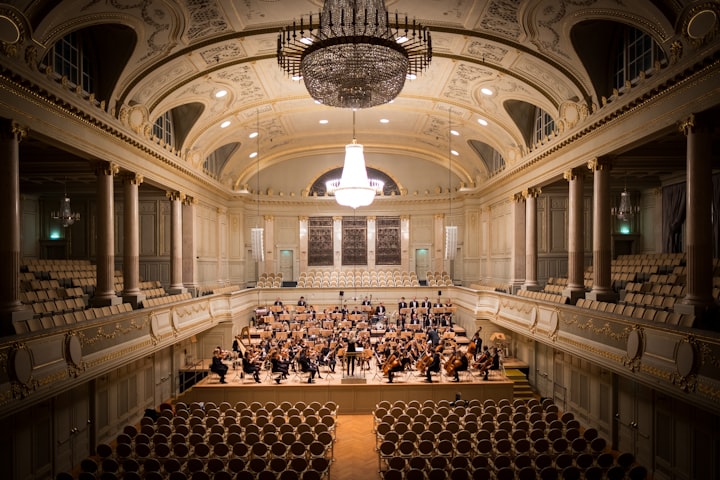
As the emergence of an official middle class rose to prominence during the nineteenth century, a new bar was set in the music industry. An entirely new economic level of people now had access to the publication of music literature, and this abundance of knowledge resulted in a greater public interest for concert performances, which in turn led to an increase of buildings specifically designed for viewing concerts primarily. Due to these radical upbringings, a standard for musical canon had been properly established and the concert hall came to be referred to as a ‘musical museum’ of sorts. Similar to a museum, the concert hall was a place where one can view the compositional masterpieces derived from the canon throughout history like grand exhibits. Music transitioned from what was once used as a simple background theme for private arrangements into a serious and educational event for a mass audience. This designation of the concert hall began to prompt composers to play it safe by basing their writings on what was well received in the past when compared to innovative work paving newfound thought provocation that has a smaller chance of being considered museum material. However, “what seemed to matter most to composers was their freedom from worldly demands” and those who split off from this convention found themselves revered even more so for their unique departures as in their writing styles and beliefs (Goehr 208).
Up until the nineteenth century, musical performances remained quite simple and traditional in execution; taking Joseph Haydn’s Surprise symphony, for example, a theme and variations form was utilized for the sake of capturing the audiences’ attention and playing off their expectations once they’ve been hooked. Ludwig van Beethoven’s work, on the other hand, is a clear-cut representation and reason for the prolific transformation of the musical canon. After living off of stipends for long enough, Beethoven made an ingenious move to Vienna for his work. Vienna serves as the perfect place for a legitimate canon considering that, at the time, there existed little to no concert culture. The debut Beethoven’s third symphony Eroica was less than stellar mainly attributed to what many considered convoluted alterations of musical customs. From the anomalous, long sequences to intentional beat and instrumental sequences being off, these practices were deemed too unusual of a typical performance. By the time his ninth symphony was performed, Beethoven began receiving critical acclaim. Much like with Eroica, this symphony also broke bounds with additions like a singers and orchestra dismissals in order to stand out. It was at this time that the idea of musical museum took root, so to see Beethoven’s ninth symphony be showered with praise illustrates how defying convention can still result in triumphant victory.
Johannes Brahms’ praise for the complexity attributed with his symphonies ties into just how similar his work is to that of Beethoven’s in terms of writing style and quirks. While Brahms was a great intellect and writer of all things music, he “delayed completing and unveiling [his] works until the 1870s, intimidated by Beethoven's long shadow” with Beethoven’s career acting as an imposing roadblock that kept Brahms from feeling confident in composing- let alone publishing symphonies (Frish 178). This anxiety made complete sense considering the two of them share strong ethical character in their writings and difficult, orchestrated attributes sprinkled within; since Beethoven came before Brahms, it’s especially difficult to regard on his own merits. For Brahms’ fourth symphony, he used an unlikely amalgamation in order to set himself apart; a combination of both historical underpinnings from the works of Bach and Beethoven as well as an old formatting form in Chaconne. While it may seem that these components fall in line to that of traditional canon, the intricate nature is so different that it manages to stand apart amongst other works of said canon. Brahms, despite being intimidated by the legacy left behind by Beethoven, forged a path he could call his own to be alongside Beethoven instead of in his shadow.
Aaron Copland’s adoption of a simple writing style in his symphonies greatly opposes a major part of what makes up traditional canon and that which is considered to be in the musical museum. According to Burkholder, “serious music became something to be ‘understood’ rather than merely enjoyed, and every member of the audience became, at least to some extent, a connoisseur,'' referring to the idea that the sheer complexity of a performance is what makes it truly canon, and Copland’s certainly sees otherwise (Burkholder 117). His personal philosophy derives more so from the idea that an audience will be drawn to something if they can interpret it with ease as a means to obtain mass appeal, not necessarily trying to attract connoisseurs exclusively. Copland perceives music as something needing to strike a balance, to appeal to a general audience with simple melodies and a more advanced audience with a distinctive American take on traditional symphonies. Copland introduces these aspects to give his compositions an American flare, fairly reminiscent of landscape and folklore found in America. Copland’s third symphony perfectly emulates that expansive feel of vast plains with narrative undertones of legends foretold of America and audiences adored it. Copland succeeds in the music world by challenging previous notions on what really makes true art music.
John Cage marks a stark contrast amongst other composers as he is quite vehemently in opposition toward what makes up the musical canon and museum. Cage is constantly and consistently in favor of creating a forum for all that is contemporary, to compose for the sake of experiencing change when listening to music. To Cage, change is essential in preserving one’s well-being and without continuously transporting ourselves, we eventually fall behind and get nowhere instantly (Cage 44). Cage’s 4’33” is a great of a grand artistic statement and concept of constant change as the performance itself is completely reliant on the audience’s interpretation and followed by their reaction to the performance. As time passes, the audience experiences a series of ebbs and flows, their perception of what’s happening constantly changing as the silence persists. Varying emotions from confusion, anger, sadness, humor, and more carry out into murmurs and gestures producing sounds that make up what is really the performance, a fascinating event that changes upon every viewing. Cage’s work is the epitome of someone who has clearly understood the impact music holds and ignored any influence historicism.
Ludwig van Beethoven, Johannes Brahms, Aaron Copland, and John Cage were all composers who helped to influence the musical canon differently in some fashion and defied the idea that it must consist primarily of by making their unique works be heard and stand out above the rest. These composers and others alike essentially expanded upon the canon, each involving their own methods and styles to help broaden the ever-expanding music world.
Works Cited
Burkholder, J. Peter. “Museum Pieces: The Historicist Mainstream in Music of the Last Hundred Years.” Journal of Musicology, vol. 2, no. 2, 1983, pp. 115–134., doi:10.1525/jm.1983.2.2.03a00010.
Cage, John. “Silence.” Lectures and Writings by John Cage. Lectures and Writings by John Cage, 1961, Middletown, Connecticut.
Frisch, Walter. Music in the Nineteenth Century. W.W. Norton and Company New York, 2012.
Goehr, Lydia. The Imaginary Museum of Musical Works: An Essay in the Philosophy of Music. Oxford University Press, 2007.






Comments
There are no comments for this story
Be the first to respond and start the conversation.